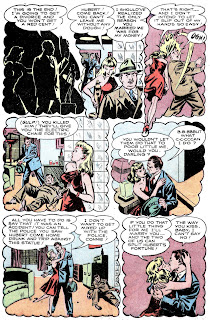Ty Cobb (1886-1961) was an awfully great baseball player and a greatly awful person. There are many stories of his nastiness. Despite the records he set and his accomplishments on the field he's just as well known for his bad temperment, his aggression and intimidation of opposing players. The story is that Cobb filed his steel cleats to be razor sharp, and when he stole bases he slid into base “with his feet up and steel showing.”
I'm sure that Ty Cobb was the inspiration for “Foul Play” in Haunt of Fear #19 (1953). The story, with its gory ending, was fairly typical EC-revenge. But it was brought before a stunned public of non-comics readers with a page in Seduction of the Innocent (1954) by Fredric Wertham, M.D.
The caption reads, “A comic-book baseball game. Notice the chest protector and other details in the text and pictures.”
In 1986 I attended a panel with Harvey Kurtzman and Jack Davis at the San Diego Con. Davis made mention of the horror comics and the trouble they caused. Speaking of the Senate hearings and uproar over them Davis said, “I'd lie awake at night and think, did I cause this?”
This is the infamous baseball story, drawn by Jack Davis, and written by editor Al Feldstein.
More about →
I'm sure that Ty Cobb was the inspiration for “Foul Play” in Haunt of Fear #19 (1953). The story, with its gory ending, was fairly typical EC-revenge. But it was brought before a stunned public of non-comics readers with a page in Seduction of the Innocent (1954) by Fredric Wertham, M.D.
The caption reads, “A comic-book baseball game. Notice the chest protector and other details in the text and pictures.”
In 1986 I attended a panel with Harvey Kurtzman and Jack Davis at the San Diego Con. Davis made mention of the horror comics and the trouble they caused. Speaking of the Senate hearings and uproar over them Davis said, “I'd lie awake at night and think, did I cause this?”
This is the infamous baseball story, drawn by Jack Davis, and written by editor Al Feldstein.












































































